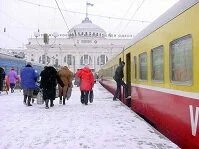Culture & Identity of Ukraine
WARNING: Ukraine is politically unstable, please read this travel warning before going!
Introduction

Getting to Odesa
The daily way of life in Ukraine varies significantly, from urban to rural areas, from ethnic Russians to ethnic Ukrainians, and most importantly from generation to generation. Growing up under Soviet rule, much of the country's older population prefers a quiet life with great stability, but today's youth seem to live more social and liberal lives as they push for even more changes.
Primarily due to Soviet rule, the people of Ukraine were heavily urbanized. Although the culture of Ukraine remains tied to village life, today nearly 70% of the people live in urban settings. Also due to Soviet rule, industry became a more prominent occupation, heavily based on the coal, metal, and power industries, even today about a quarter of the people work in industries with only about 5% working in agriculture. Today most of the people work in the services industries.
For most people, no matter their occupation, the day begins with a simple breakfast followed by work, which usually begins at about 9:00 am. Public transportation is the most common way for people to get to and from work as the infrastructure in the country is quite impressive (but slow). The work day for many goes until about 5:00 or 6:00 pm, when people hang out with friends or return home to eat and spend time with family. Despite the regular hours and long working shifts, the pay in Ukraine is not great as the GDP per capita is only $7,500 US although wages vary substantially from industry to industry.